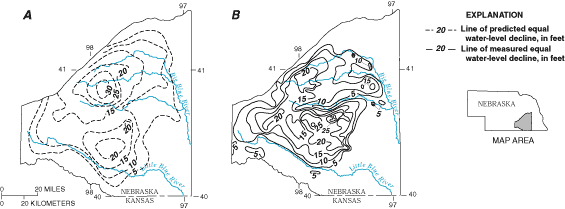
Sustainability of Ground-Water Resources--Circular 1186
Computer simulation models of flow and transport are a principal means for evaluating the response of aquifer systems to ground-water withdrawals and other human activities. There is a tendency to view development of such models as a one-time activity. However, if a model is used to address questions about the future responses of a ground-water system that are of continuing significance to society, then field monitoring of the ground-water system should continue and the model should be reevaluated periodically to incorporate new information or new insights (Konikow and Reilly, 1999). For example, it might be desirable to add new capabilities to an existing model, such as interactions between ground water and surface-water bodies.
Ground-water models commonly are used to make forecasts for a decade or more in the future. Confidence in the reliability of a ground-water model is dependent in large part upon the quality and extent of historical data used to calibrate and test the model. In recent years, studies have been made of the accuracy of selected model forecasts several years after the date for which the forecasts had been made. Such studies, commonly referred to as post audits, offer a means to evaluate overall performance of a model and the nature and magnitude of model forecasting errors. Post audits also provide insights into possible future model enhancements.
As an example, a post audit was made for a ground-water model of the Blue River Basin, a heavily irrigated area in southeastern Nebraska. Forecasts of water-level declines for 1982 made by the model in 1965 were compared to measured 1982 water-level declines as shown in Figure F-1 (Alley and Emery, 1986). Overall, the forecasted and measured water-level declines were somewhat similar in magnitude, although clearly more complexity is shown by the measured water-level declines. Further examination during the post audit revealed that irrigation demand had been greatly underestimated for the forecast period between 1965 and 1982. If the actual ground-water withdrawals had been incorporated in the 1965 model, forecasted water-level drawdowns for 1982 would have been much greater than the measured drawdowns in 1982. Apparently, the aquifer storage coefficient used in the 1965 model was too low, and the model underestimated contributions to pumpage from sources other than depletion of aquifer storage. For example, streamflow depletion appears to have been underestimated.
One of the limitations of the Blue River Basin model was that ground-water development was relatively limited at the time of original model calibration. For example, the only area of significant water-level decline in 1965 was in the northern part of the basin. A common finding of post audits of ground-water model forecasts is that the time period for matching historical conditions in the original model was too short to capture important elements of the ground-water system in the model. Processes or boundary conditions that are insignificant under the initial, lower stress regime may become important under a different and generally larger set of imposed stresses. Thus, a conceptual model founded on observed behavior of a ground-water system may provide inaccurate forecasts if existing stresses are increased or new stresses are added. In addition, as illustrated by the Blue River Basin modeling study, future projections of water withdrawals typically are highly uncertain and need to be refined with time. The possibility of periodic refinement and reuse of ground-water models highlights the importance of thorough documentation and careful archiving of these models and continued monitoring of the ground-water system.

Figure F-1. (A) Predicted and (B) measured ground-water-level declines in the Blue River Basin from predevelopment to 1982. (Emery, 1965; Johnson and Pederson, 1983.)